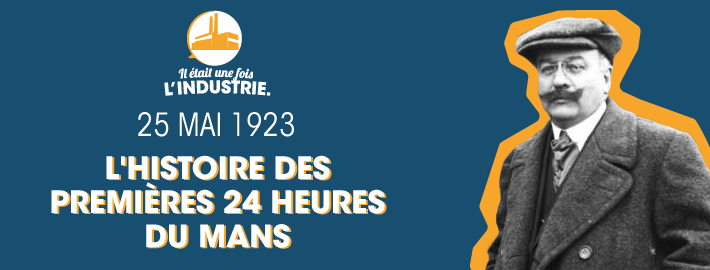GLOBAL
INDUSTRIE
News
Share on

The 25th of May 1923 or the story of the first 24 Hours of Le Mans
What happened this week in the History of Industry? It is to answer this question that we invite you to rediscover, every week, a historical event which occurred around this time… in another age. This week, let’s go back nearly a century to witness the birth of a legendary motor race - but also an industrial race!
A RACE AGAINST THE CLOCK
The great architect of the 24 Hours of Le Mans, who was to be the driving force behind this event for years, was Georges Durand. Born on the 30th of April 1864 in Fresnay-sur-Sarthe, into a humble family of weavers, at the age of 20 he went to live in Le Mans where he worked for the Highway Department. Talented, the young man quickly made a name for himself and rose through the ranks.
Thus it was that in October 1905 this car enthusiast teamed up with local manufacturers to create a committee to promote the Sarthe department’s bid to host the first Grand Prix of the Automobile Club de France (ACF). This initiative was crowned with success when they were awarded the prestigious event. Just eight months later, the first ACF Grand Prix thus took place in Le Mans on the 25th and 26th of June 1906 on the future 24 Hours of Le Mans circuit. This achievement was all the more remarkable because it was only on the 24th of January of the same year that the official articles of association were filed for what was to become the Automobile Club de l’Ouest (ACO), of which Durand was appointed General Secretary, a position he was to hold until his death.
BEWARE OF THE RACERS!
Very quickly, however, Georges Durand and his associates went their own way by inventing a competition of their own with the express aim of contributing to technical progress and to the growth of this means of transport, which was still in its infancy. Thus, mandated by the ACO’s management committee, he took advantage of the 1922 Paris Motor Show to meet Charles Faroux, a journalist who had graduated from the Ecole Polytechnique, and the industrialist Émile Coquille.
The three men agreed to create a new type of race, based on endurance rather than speed, which would serve both to demonstrate the quality of the vehicles and to generate technological improvements. Charles Faroux proposed an eight-hour race, including four hours at night, but Georges Durand exclaimed: "Why not 24 hours?". To which Charles Faroux replied: "that would be perfect... but you’ll never get the permits for it!" In the words of Brassens’ song, “the next events proved him wrong…”
Shortly afterwards, indeed, the ACO officially announced the creation of a new type of competition in Sarthe: a 24-hour endurance test in which teams of two drivers per car would take turns to drive day and night. The first edition, involving 33 teams, was held on the 26th and 27th of May 1923 on the Circuit de la Sarthe. It was won by the French team of André Lagache and René Léonard, who completed 128 laps in a Chenard & Walcker at an average speed of 92.064 km/h.
AN OPEN-AIR LABORATORY
Since then, unless a calamity such as a World War or Covid has interfered, the oldest and most prestigious endurance race in the world has been held every year in June. For nearly a century, it has served as a testing ground for a host of improvements: disk brakes, rims, aerodynamics, radial tires and fog lights, LED headlights and laser headlights are thus among the numerous innovations tested at this event. This is not to mention the various types of engines used both to gain in speed and to reduce fuel consumption, pending the car running entirely on hydrogen scheduled for 2024. The Hunaudières straight was even proclaimed a "national laboratory" in 1932 by the French Highway Department.
Georges Durand, for his part, left an indelible trace in Le Mans, where he died on the 3rd of May 1941 after being awarded the Legion of Honor. His name was given to the avenue which extends in line with the prestigious straight and continues into the town centre. The last loop of the circuit is thus completed!
"True success for a team is being competitive in the long term" – Alain Prost
OTHER EVENTS WHICH HAPPENED THIS WEEK:
- 24 May (1830): opening of one of the first railway lines in the United States, the Baltimore and Ohio Railroad, between Baltimore and Ellicott City in Maryland
- 24 May (1903): the Paris-Madrid motor race, one of the first in History, is brought to halt in Bordeaux
- 24 May (1941): the German battleship Bismarck sinks the British battle cruiser HMS Hood in the Atlantic after a few minutes of engagement
- 25 May (1928): during the Italian explorer Umberto Nobile’s second polar expedition, his airship Italia crashes to the north of Spitsbergen
- 26 May (1972): Wernher von Braun, a former favorite of Adolf Hitler, resigns from a leading position at… NASA
- 26 May (2017): start of the construction of the European Extremely Large Telescope in Chile
- 27 May (1931): Auguste Piccard makes the first flight in the stratosphere in a free balloon
- 28 May (1934): Paul Codos and Maurice Rossi are the first aviators to successfully fly across the Pacific in both directions
- 28 May (2016): official launch of FRIPON, a network of cameras designed to monitor French skies to track meteorites
- 30 May (1911): first running of the Indianapolis 500
- 30 May (1966): launch of the American space probe Surveyor 1 to explore the Moon
- 30 May (1971): launch of the orbiter Mariner 9, the first spacecraft to study Mars from orbit
- 30 May (1975): signing of the Convention creating the European Space Agency in Paris
2021.05.25